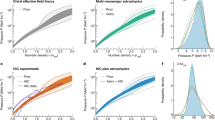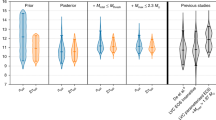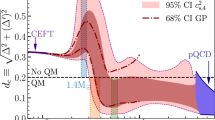Abstract
With recent advances in neutron star observations, major progress has been made in determining the pressure of neutron star matter at high density. This pressure is constrained by the neutron star deformability, as determined from gravitational waves emitted in a neutron star merger, and measurements of the radii of two neutron stars made using the Neutron Star Interior Composition Explorer X-ray observatory on the International Space Station. Previous studies have relied on nuclear theory calculations to provide the equation of state at low density. Here we use a combination of 15 constraints composed of three astronomical observations and 12 nuclear experimental constraints that extend over a wide range of densities. Bayesian inference is then used to obtain a comprehensive nuclear equation of state. This data-centric result provides benchmarks for theoretical calculations and modelling of nuclear matter and neutron stars. Furthermore, it provides insights into the composition of neutron stars and their cooling due to neutrino radiation.
This is a preview of subscription content, access via your institution
Access options
Access Nature and 54 other Nature Portfolio journals
Get Nature+, our best-value online-access subscription
$29.99 / 30 days
cancel any time
Subscribe to this journal
Receive 12 digital issues and online access to articles
$119.00 per year
only $9.92 per issue
Buy this article
- Purchase on Springer Link
- Instant access to full article PDF
Prices may be subject to local taxes which are calculated during checkout




Similar content being viewed by others
Code availability
Analysis codes specially written for this work are available online at https://github.com/nscl-hira/TidalPolarizabilityPublic. The TOV solver used in this work is available upon request to the corresponding author.
References
Lattimer, J. M. & Prakash, M. The physics of neutron stars. Science 304, 536–542 (2004).
Dietrich, T. et al. Multimessenger constraints on the neutron-star equation of state and the Hubble constant. Science 370, 1450–1453 (2020).
Hen, O. From nuclear clusters to neutron stars. Science 371, 232–232 (2021).
Abbott, B. P. et al. Multi-messenger observations of a binary neutron star merger. Astrophys. J. Lett. 848, L12 (2017).
Abbott, B. P. et al. GW170817: observation of gravitational waves from a binary neutron star inspiral. Phys. Rev. Lett. 119, 161101 (2017).
Riley, T. E. et al. A NICER view of PSR J0030+0451: millisecond pulsar parameter estimation. Astrophys. J. Lett. 887, L21 (2019).
Miller, M. C. et al. PSR J0030+0451 mass and radius from NICER data and implications for the properties of neutron star matter. Astrophys. J. 887, L24 (2019).
Riley, T. E. et al. A NICER view of the massive pulsar PSR J0740+6620 informed by radio timing and XMM-Newton spectroscopy. Astrophys. J. Lett. 918, L27 (2021).
Miller, M. C. et al. The radius of PSR J0740+6620 from NICER and XMM-Newton data. Astrophys. J. Lett. 918, L28 (2021).
Legred, I., Chatziioannou, K., Essick, R., Han, S. & Landry, P. Impact of the PSR J0740 + 6620 radius constraint on the properties of high-density matter. Phys. Rev. D 104, 063003 (2021).
Abbott, B. P. et al. GW170817: measurements of neutron star radii and equation of state. Phys. Rev. Lett. 121, 161101 (2018).
Danielewicz, P., Lacey, R. & Lynch, W. G. Determination of the equation of state of dense matter. Science 298, 1592–1596 (2002).
Le Fevre, A., Leifels, Y., Reisdorf, W., Aichelin, J. & Hartnack, C. Constraining the nuclear matter equation of state around twice saturation density. Nucl. Phys. A 945, 112–133 (2016).
Dutra, M. et al. Skyrme interaction and nuclear matter constraints. Phys. Rev. C 85, 035201 (2012).
Zhang, Z. & Chen, L.-W. Electric dipole polarizability in 208Pb as a probe of the symmetry energy and neutron matter around ρ0/3. Phys. Rev. C 92, 031301 (2015).
Adhikari, D. et al. Accurate determination of the neutron skin thickness of 208Pb through parity-violation in electron scattering. Phys. Rev. Lett. 126, 172502 (2021).
Reed, B. T., Fattoyev, F. J., Horowitz, C. J. & Piekarewicz, J. Implications of PREX-2 on the equation of state of neutron-rich matter. Phys. Rev. Lett. 126, 172503 (2021).
Brown, B. A. Constraints on the Skyrme equations of state from properties of doubly magic nuclei. Phys. Rev. Lett. 111, 232502 (2013).
Kortelainen, M. et al. Nuclear energy density optimization: large deformations. Phys. Rev. C 85, 024304 (2012).
Danielewicz, P., Singh, P. & Lee, J. Symmetry energy III: isovector skins. Nucl. Phys. A 958, 147–186 (2017).
Tsang, M. B. et al. Constraints on the density dependence of the symmetry energy. Phys. Rev. Lett. 102, 122701 (2009).
Morfouace, P. et al. Constraining the symmetry energy with heavy-ion collisions and Bayesian analyses. Phys. Lett. B 799, 135045 (2019).
Estee, J. et al. Probing the symmetry energy with the spectral pion ratio. Phys. Rev. Lett. 126, 162701 (2021).
Cozma, M. Feasibility of constraining the curvature parameter of the symmetry energy using elliptic flow data. Eur. Phys. J. A 54, 1–23 (2018).
Russotto, P. et al. Symmetry energy from elliptic flow in 197Au + 197Au. Phys. Lett. B 697, 471–476 (2011).
Russotto, P. et al. Results of the ASY-EOS experiment at GSI: the symmetry energy at suprasaturation density. Phys. Rev. C 94, 034608 (2016).
Miller, M. C., Chirenti, C. & Lamb, F. K. Constraining the equation of state of high-density cold matter using nuclear and astronomical measurements. Astrophys. J. 888, 12 (2019).
Lynch, W. & Tsang, M. Decoding the density dependence of the nuclear symmetry energy. Phys. Lett. B 830, 137098 (2022).
Tsang, M. B. et al. Isospin diffusion and the nuclear symmetry energy in heavy ion reactions. Phys. Rev. Lett. 92, 062701 (2004).
Tsang, M. B. et al. Constraints on the symmetry energy and neutron skins from experiments and theory. Phys. Rev. C 86, 015803 (2012).
Drischler, C., Hebeler, K. & Schwenk, A. Chiral interactions up to next-to-next-to-next-to-leading order and nuclear saturation. Phys. Rev. Lett. 122, 042501 (2019).
Drischler, C., Hebeler, K. & Schwenk, A. Asymmetric nuclear matter based on chiral two- and three-nucleon interactions. Phys. Rev. C 93, 054314 (2016).
Adamczewski-Musch, J. et al. Directed, elliptic, and higher order flow harmonics of protons, deuterons, and tritons in Au + Au collisions at \(\sqrt{{s}_{NN}}=2.4\,{\rm{GeV}}\). Phys. Rev. Lett. 125, 262301 (2020).
Abdallah, M. S. et al. Flow and interferometry results from Au + Au collisions at \(\sqrt{{s}_{NN}}=4.5\,{\rm{GeV}}\). Phys. Rev. C 103, 034908 (2021).
Abdallah, M. S. et al. Disappearance of partonic collectivity in \(\sqrt{{s}_{\rm{NN}}}=3\,{\rm{GeV}}\) Au + Au collisions at RHIC. Phys. Lett. B 827, 137003 (2022).
Abbott, B. P., Abbott, R., Abbott, T. D. & Abraham, S. et al. GW190425: observation of a compact binary coalescence with total mass ~ 3.4 M⊙. Astrophys. J. Lett. 892, L3 (2020).
Fonseca, E. et al. Refined mass and geometric measurements of the high-mass PSR J0740+6620. Astrophys. J. Lett. 915, L12 (2021).
Cromartie, H. T. et al. Relativistic Shapiro delay measurements of an extremely massive millisecond pulsar. Nat. Astron. 4, 72–76 (2020).
Tsang, C. Y., Tsang, M. B., Danielewicz, P., Lynch, W. G. & Fattoyev, F. J. Impact of the neutron-star deformability on equation of state parameters. Phys. Rev. C 102, 045808 (2020).
Tolman, R. C. Static solutions of Einstein’s field equations for spheres of fluid. Phys. Rev. 55, 364–373 (1939).
Oppenheimer, J. R. & Volkoff, G. M. On massive neutron cores. Phys. Rev. 55, 374–381 (1939).
Baym, G., Pethick, C. & Sutherland, P. The ground state of matter at high densities: equation of state and stellar models. Astrophys. J. 170, 299 (1971).
Huth, S. et al. Constraining neutron-star matter with microscopic and macroscopic collisions. Nature 606, 276–280 (2022).
Lattimer, J. M., Pethick, C. J., Prakash, M. & Haensel, P. Direct Urca process in neutron stars. Phys. Rev. Lett. 66, 2701–2704 (1991).
Page, D., Lattimer, J. M., Prakash, M. & Steiner, A. W. Minimal cooling of neutron stars: a new paradigm. Astrophys. J. Suppl. Ser. 155, 623 (2004).
Brown, E. F. et al. Rapid neutrino cooling in the neutron star MXB 1659-29. Phys. Rev. Lett. 120, 182701 (2018).
Shternin, P. S., Yakovlev, D. G., Heinke, C. O., Ho, W. C. G. & Patnaude, D. J. Cooling neutron star in the Cassiopeia A supernova remnant: evidence for superfluidity in the core. Mon. Not. R. Astron. Soc. 412, L108–L112 (2011).
Capano, C. D. et al. Stringent constraints on neutron-star radii from multimessenger observations and nuclear theory. Nat. Astron. 4, 625 (2020).
Ghosh, S., Chatterjee, D. & Schaffner-Bielich, J. Imposing multi-physics constraints at different densities on the neutron star equation of state. Eur. Phys. J. A 58, 37 (2022).
Drischler, C., Furnstahl, R. J., Melendez, J. A. & Phillips, D. R. How well do we know the neutron-matter equation of state at the densities inside neutron stars? A Bayesian approach with correlated uncertainties. Phys. Rev. Lett. 125, 202702 (2020).
Drischler, C., Melendez, J. A., Furnstahl, R. J. & Phillips, D. R. Quantifying uncertainties and correlations in the nuclear-matter equation of state. Phys. Rev. C 102, 054315 (2020).
Sorensen, A. et al. Dense nuclear matter equation of state from heavy-ion collisions. Prog. Part. Nucl. Phys. https://doi.org/10.1016/j.ppnp.2023.104080 (2022).
Li, B.-A., Chen, L.-W. & Ko, C. M. Recent progress and new challenges in isospin physics with heavy-ion reactions. Phys. Rep. 464, 113–281 (2008).
Margueron, J., Hoffmann Casali, R. & Gulminelli, F. Equation of state for dense nucleonic matter from metamodeling. I. Foundational aspects. Phys. Rev. C 97, 025805 (2018).
Dutra, M. et al. Relativistic mean-field hadronic models under nuclear matter constraints. Phys. Rev. C 90, 055203 (2014).
Adamczewski-Musch, J. et al. Proton, deuteron and triton flow measurements in Au + Au collisions at \(\sqrt{{s}_{{{{\rm{NN}}}}}}=2.4\,{\rm{GeV}}\). Eur. Phys. J. A 59, 80 (2023).
Pinkenburg, C. et al. Elliptic flow: transition from out-of-plane to in-plane emission in Au + Au collisions. Phys. Rev. Lett. 83, 1295–1298 (1999).
Liu, H. et al. Sideward flow in Au + Au collisions between 2A and 8A GeV. Phys. Rev. Lett. 84, 5488–5492 (2000).
Oliinychenko, D., Sorensen, A., Koch, V. & McLerran, L. Sensitivity of Au + Au collisions to the symmetric nuclear matter equation of state at 2–5 nuclear saturation densities. Phys. Rev. C 108, 034908 (2023).
Bayes, T. & Price, R. An essay towards solving a problem in the doctrine of chance. By the late Rev. Mr. Bayes, communicated by Mr. Price, in a letter to John Canton, A. M. F. R. S. Philos. Trans. R. Soc. Lond. 53, 370–418 (1763).
Acknowledgements
We would like to acknowledge many stimulating discussions with the participants at the workshops sponsored by the Institute of Nuclear Theory in 2021 and 2022 and with members of the Transport Model Evaluation Project. We are grateful to C. Drischler for providing the χEFT calculations shown in our figures. This work is supported in part by the National Science Foundation (Grant No. PHY-2209145 to R.K., W.G.L., C.Y.T. and M.B.T.) and the US Department of Energy, Office of Science, Office of Nuclear Physics (Grant No. DE-FG02-87ER40365 to C.J.H.). The Facility for Radioactive Ion Beams (FRIB), funded by the US Department of Energy, is committed to fostering a safe, diverse, equitable and inclusive work and research environment in which respect and personal integrity are valued. We adhere to the FRIB research code of conduct in accordance with the highest scientific, professional and ethical standards, as detailed in https://frib.msu.edu/users/pac/conduct.html. In an ideal world, it should not be necessary to identify the authors by gender or from under-represented group. Until the ideal world is reached, we acknowledge that our references and citations most likely under-represent contributions from women and minorities. We further acknowledge that Michigan State University occupies the ancestral, traditional and contemporary lands of the Anishinaabeg and the Three Fires Confederacy of the Ojibwe, Odawa and Potawatomi peoples. In particular, the university resides on land ceded in the 1819 Treaty of Saginaw.
Author information
Authors and Affiliations
Contributions
C.Y.T. and M.B.T. first conceived the project. C.Y.T. wrote the software for the Bayesian analysis. C.Y.T., M.B.T. and W.G.L. collected and evaluated all the constraints used in the analysis. R.K. researched, reviewed and validated the final set of constraints adopted in Table 1. R.K. also wrote some of the software codes used to analyse the Bayesian results and generated all the figures with data. C.J.H. contributed to the impact of the Urca cooling section. All authors contributed to the writing, editing and revising of the manuscript. The ordering of the authors reflects the length of time the authors have joined the project.
Corresponding author
Ethics declarations
Competing interests
The authors declare no competing interests.
Peer review
Peer review information
Nature Astronomy thanks the anonymous reviewers for their contribution to the peer review of this work.
Additional information
Publisher’s note Springer Nature remains neutral with regard to jurisdictional claims in published maps and institutional affiliations.
Supplementary information
Supplementary Information
Supplementary Figs. 1 and 2 and Table 1.
Rights and permissions
Springer Nature or its licensor (e.g. a society or other partner) holds exclusive rights to this article under a publishing agreement with the author(s) or other rightsholder(s); author self-archiving of the accepted manuscript version of this article is solely governed by the terms of such publishing agreement and applicable law.
About this article
Cite this article
Tsang, C.Y., Tsang, M.B., Lynch, W.G. et al. Determination of the equation of state from nuclear experiments and neutron star observations. Nat Astron 8, 328–336 (2024). https://doi.org/10.1038/s41550-023-02161-z
Received:
Accepted:
Published:
Issue Date:
DOI: https://doi.org/10.1038/s41550-023-02161-z



